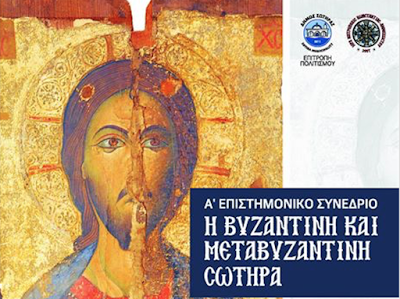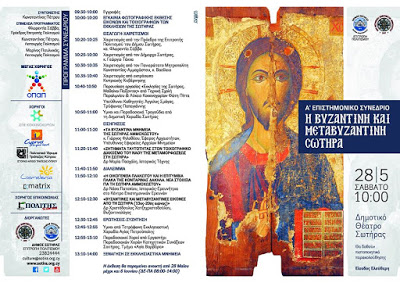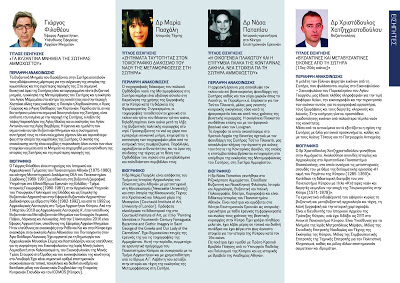The First Scientific Conference "The Byzantine and Post-Byzantine Savior" is organized on Saturday, May 28, 2016, by the Municipality of Sotiras in collaboration with the Holy Diocese of Constantia - Famagusta.
The conference will be held at ten in the morning at the Municipal Theater of Sotira and its goal is, according to a written announcement, "the promotion of Byzantine and Post-Byzantine History and the cultural heritage of both Sotira and the wider province of Famagusta."
The speakers of the Conference will be Dr. Christodoulos Chatzichristodoulou, Byzantinologist, Dr. Maria Paschali, Art Historian, Dr. Nassa Patapiou, Historian - Researcher at the Center for Scientific Research and George Filotheou, Curator of Antiquities, Head of the Ephorate of Ancient Monuments.
According to the announcement, "after the presentations, there will be an artistic program with hymns and traditional songs by the Sotiras Municipal Choir, dances by the Sotiras Traditional Dance Workshop and hymns by the Four-voiced Ecclesiastical Choir of St. Petersburg. A tour of the ecclesiastical monuments and the Ecclesiastical Museum - Icon of the Savior will follow ".
Throughout the Conference "there will be a photo exhibition with frescoes and icons of the Byzantine churches of the Savior in the area of the Municipal Palace of the Savior. There will also be a presentation of the thematic diary and application created by the students of the Technical School of Paralimni and the Lyceum of Kokkinochorion "Foti Pitta" with the ecclesiastical monuments of the Savior ".
The Municipality of Sotira, continues the announcement, "aspires that the Scientific Conference be established to take place every year and will address issues of history and cultural heritage of Sotira and the wider province of Famagusta."
It is noted that the First Scientific Conference "is held on the occasion of the research conducted by the University of Cyprus and the AG Foundation. Leventis in the Basilica of the Savior of Famagusta (Church of the Transfiguration of the Savior) ".
The Rapporteurs:
Dr. Christodoulos Chatzichristodoulou, Byzantine scholar
TITLE OF PRESENTATION: "BYZANTINE AND POST-BYZANTINE ICONS FROM THE SAVIOR (13th -20th century)"
ANNOUNCEMENT SUMMARY:
The study of the wooden portable icons by Sotira, which are kept mainly in the Icon - Sacristy of the Chapel of Agios Georgios, gave us a lot of information about the price of various Saints, the iconography and the style of these icons, about the hagiographic workshops, the painters and donors, clergy and laity. In the presentation, an attempt is made to group images from older temples of the community.
Through these objects, the Savior's relationship with other neighboring pilgrimages is examined, as well as with the Holy Land and the Patriarchate of Antioch.
RESUME:
Dr. Christodoulos Hadjichristodoulou was born in Famagusta. He studied History and Archeology at the Aristotle University of Thessaloniki, where he continued his postgraduate studies on the thesis "The prosperity of the Rigat of Cyprus (1285-1369)". He submitted his doctoral dissertation at the University of Cyprus entitled "Temple owners and heir donors during the Turkish occupation in Cyprus (1571-1878)".
His research interests mainly concern Byzantine and post-Byzantine archeology and art, folk painting and historical cartography.
He is the director of the Historical Archive of the Bank of Cyprus, while he has taught as a SEP at the Open University of Cyprus. He is Responsible for the Monuments of the Holy Metropolis of Morphou, Member of the Synodal Committee for Architecture and Art of the Church of Cyprus, Member of the Advisory Committee of the Technical Committee for Cultural Heritage, as well as a member of other scientific associations and institutions.
Dr. Nasa Patapiou, historian-researcher at the Center for Scientific Research
TITLE OF PRESENTATION: “THE PLAKOTOS FAMILY AND THE TOMB PLATE OF KONTARINA DAKILA. NEW FACTS ABOUT THE SAVIOR OF FAMAGUSTA "
ANNOUNCEMENT SUMMARY:
Our archival research revealed the last feudal lord of Sotira during the Venetian rule, as well as of the surrounding villages such as Liopetri, Paralimni, etc. It was Toutios Plakotos, a member of a well-known Cypriot family both during the Frankish rule and during the times of Venetian rule. The Plakotos family was also associated with the Frankish royal house of Lusignan.
The documents that we discovered in the State Archive of Venice about the feudal lord of the Savior Toutios Plakotos, fully revealed to us the centuries-old identity of Kontarina Dakila, whose tombstone is on the lintel of the church of the Transfiguration in Sos. .
RESUME:
Dr. Nasa Patapiou was born in Rizokarpaso, Famagusta. He studied Byzantine and Modern Greek Philology, History and Archeology, Byzantine and Italian Paleography, Theater, Choreography and holds a PhD in History from the University of Athens. She is a poet and works at the Center for Scientific Research as a historian-researcher with a field of research on Frankish rule and especially the times of Venetian rule in Cyprus. He has written numerous studies, participated in local and international conferences and has brought to light unknown facts about the history of Cyprus during the 16th century.
As a poet she has been honored with the First State Poetry Prize by the Ministry of Education and Culture of Cyprus and as a historian with the Prize of the Academy of Athens.
Dr. Maria Paschali, Art Historian
TITLE OF PRESENTATION: "IDENTITY ISSUES IN THE WALL PAINTING DECORATION OF THE TEMPLE OF THE TRANSFORMATION IN THE SAVIOR"
ANNOUNCEMENT SUMMARY:
The fresco decoration of the old Orthodox Church of the Transfiguration in Sotira provides a remarkable ensemble in the investigation of the use of painting in Cyprus during the Frankish occupation. Specifically, the frescoes are placed in the last third of the thirteenth century, ie about a century after the end of Byzantine political rule on the island. Approaching the church as a place that contains social memory, an attempt is made to understand the frescoes through their Cypriot contexts. At the same time, the possibilities and limits of the connection of art with the position of the Orthodox of the island in their changing and multidimensional environment are commented.
RESUME:
Maria Paschali is a graduate of the Department of History-Archeology of the University of Athens with postgraduate studies in Museology (Newcastle University) and in the History of Medieval Art in the Christian and Islamic area of the Mediterranean (Courtauld Institute of Art, University of London). She recently completed her PhD at the Courtauld Institute of Art, entitled "Painting Identities in Fourteenth-Century Famagusta: Byzantine and Gothic Imagery in Saint George of the Greeks and Our Lady of the Carmelites". She has published aspects of her research on the frescoes of Famagusta. Currently, he participates in a research program of the University of Cyprus in collaboration with the Department of Antiquities and with funding from the AG Foundation. Leventi that focuses on the history and art of the church of the Transfiguration in the Savior.
Mr. George Filotheou, Curator of Antiquities, Department of Antiquities
TITLE OF PRESENTATION: "THE BYZANTINE MONUMENTS OF THE SAVIOR OF FAMAGUSTA"
ANNOUNCEMENT SUMMARY:
The Byzantine Monuments that are preserved in Sotira are the undeniable witnesses for the tracing of the history of the town and its wider area. In the current administrative boundaries of Sotira are recorded five Byzantine monuments, the church of the Transfiguration of the Savior and the church of Agios Mamas in the center of the community and in the area of Hortakia three other churches, Panagia Chordakiotissa, Agios Georgios and Agios Theos Χορτακιών. Nevertheless, although they do not belong within the current administrative boundaries of Sotira, they are completely identified with the area of Sotira, the carved tomb / chapel of Agia Thekla and the churches of Agios Antonios and Agia Varvara.
The research and study of these important Byzantine Monuments and their systematic maintenance in recent years shed more and more light on the history of the town of Sotira. The purpose of this announcement is precisely the presentation of all these new elements and through the Monuments to attempt a recomposition of the history of the Savior and its wider area.
RESUME:
George Filotheou is a graduate of the Department of History and Archeology of the University of Athens (1975-1980) and holds a DEA Postgraduate Diploma from the Sorbonne University (1989-1991) specializing in Byzantine painting. He served at the National Research Foundation of Greece - Department of Historical Geography (1980-1981), at the Archaeological Service of the Ministry of Culture of Greece and as Curator of Byzantine Antiquities at the Ephorate of Byzantine Antiquities of Dodecanese based in Rhodes (from 1982-1992), Archaeological Officer at the Department of Antiquities of Cyprus.
From March 1, 2010 as Archaeological Officer of AD, he was in charge of Byzantine and Post-Byzantine Monuments of the Provinces of Limassol, Paphos, Larnaca and Nicosia. Since January 1, 2016 he is the Curator of Antiquities, responsible for the Ephorate of Ancient Monuments.
He was responsible for excavations in Rhodes and Kos and in Cyprus he has excavated in the church of Agios Athanasios of Pentaschonitis in Agios Theodoros Larnaca. He has worked for the creation of the Archaeological Museums of Symi and Kastellorizo and as responsible for the formation of the Iconostasis of the Holy Monastery of Ioannis Lampadistis in Kalopanagiotis, the Iconoclasm of the Holy Cross Monastery in Omodos and the iconostasis of the community in Lou.
He has made a significant number of scientific announcements in local, national and international sessions and was a member of the Boards of Directors of the Society of Cyprus Studies and ICOMOS (Cyprus).
SotiraNews



